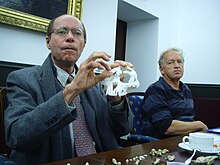Tim White
Timothy Douglas White (born August 24, 1950 in Los Angeles , California ) is an American paleoanthropologist . He became internationally known in specialist circles when he published the first description of the new species Australopithecus afarensis in 1978 together with Donald Johanson and Yves Coppens . Since 1986 he has been Professor of Anthropology at the University of California, Berkeley . Since 1995 he has been Professor of Integrative Biology at this university and one of the directors of the Laboratory for Human Evolutionary Studies founded by Francis Clark Howell . In 2009 he published the description of the fossil Ardi as one of the main authors .
Career
Raised in Lake Arrowhead , California, Tim White studied biology and anthropology at the University of California, Riverside , where he graduated with a bachelor's degree in both subjects in 1972 . In 1974 he received a Master's degree in Biological Anthropology from the University of Michigan, Ann Arbor , and in 1977 he was awarded a master's degree in the same subject at the Institute of Milford H. Wolpoff with a study on “The Anterior Mandibular Corpus of Early African Hominidae: Functional Significance of Shape and Size " doctorate . He then worked for a year as a visiting lecturer , then as an associate professor until 1982 and as an associate professor in Ann Arbor from 1982 to 1986 .
Between 1979 and 1992 Tim White worked as an expert for forensic osteology for the defense at different court locations . Since 1991 he has been curator for anthropology at the PA Hearst Museum at the University of California, Berkeley, and since 2003 advisor to the Museum of the African Diaspora in San Francisco , and since 2001 he has also worked at the National Academy of Sciences .
Research work
As early as 1966, White had worked on archaeological research projects in the San Bernardino Mountains in California and in the Mojave Desert , in which relics of early Indian settlements were examined; until 1973 he kept this vacation employment regularly. From 1974 to 1976 he worked as a paleontologist at the East Rudolf Research Project in Northern Kenya . In the beginning, this was also a pure summer vacation job, which should bring him additional experience in field research, which should be useful for his doctoral thesis. But the collaboration with excavation manager Richard Leakey in Koobi Fora was so successful that he recommended him to his mother Mary Leakey to document her findings of Australopithecus fossils from Laetoli ( Tanzania ). In 1978 he was also busy uncovering the famous footprints of two early pre-humans at the same location .
This collaboration with Mary Leakey made contact with Donald Johanson , who had also discovered Australopithecus fossils in the Afar Triangle ( Ethiopia ) , including the famous Lucy in 1974 . After several years of hesitation, the fossils from the Afar region and from Laetoli were described by Johanson, White and the French Yves Coppens as the new species Australopithecus afarensis , which is now considered to be the earliest pre-human species in the hominini tribe .
From 1979 field studies followed in various other excavation areas in Africa, Jordan and Eastern Turkey, and White also examined numerous fossil finds in museums. Since 1990 he has been the paleoanthropological team leader in the Middle Awash Research Area at Middle Awash in Ethiopia.
White's discoveries include a. Ardipithecus ramidus , whose bone structure and teeth gave a first indication that the ancestors of man acquired the ability to walk upright in the woods and not later in the open savannah . The Australopithecus garhi, described together with Berhane Asfaw , as well as an almost 160,000 year old archaic Homo sapiens , called Homo sapiens idaltu , are also considered outstanding .
A 2001 CNN report reported that White hoped he would be remembered after his death not just for his spectacular finds, but primarily for the way they were made. Tim White was literally quoted as saying: "One of the things I am particularly proud of is that we have included so many Africans in our research because they will carry the knowledge forward into the next generation of researchers."
In 2000 White was elected to the National Academy of Sciences and in 2002 to the American Academy of Arts and Sciences .
Publications
- with Donald Johanson and Yves Coppens : A New Species of the Genus Australopithecus (Primates: Hominidae) from the Pliocene of Eastern Africa. In: Kirtlandia, No. 28, 1978.
- Prehistoric Cannibalism at Mancos 5MTUMR-2346. Princeton University Press, Princeton 1992.
- with A. Defleur and others: Neanderthal Cannibalism at Moula-Guercy, Ardèche, France. In: Science 286, 1999, pp. 128-131.
- The Human Bone Manual. Elsevier Academic Press, Burlington (Massachusetts) 2005.
- with others: Ardipithecus ramidus, a root species for Australopithecus. In: Fiorenzo Facchini (ed.): The Colloquia of the XIII. International Congress of Prehistoric and Protohistoric Sciences, Forli, Italy, September 8-14, 1996. ABACO srl., Forli., Pp. 15-23, ISBN 88-86712-27-8 .
- with Berhane Asfaw and others: Australopithecus garhi: A new species of early hominid from Ethiopia. In: Science Volume 284, 1999, pp. 629-635.
Web links
- Tim White's website in Berkeley
- Middle Awash Research Project website
- Howard Hughes Medical Institute Human Evolution and the Nature of Science and Hominid Paleobiology . Two videos of the 1st and 4th lecture from the Holiday Lectures series : Bones, Stones, and Genes - The Origin of Modern Humans from 2011
swell
- Tim White curriculum vitae
- ↑ Tim D. White, Berhane Asfaw et al .: Pleistocene Homo sapiens from Middle Awash, Ethiopia. In: Nature . Volume 423, 2003, pp. 742-747, doi: 10.1038 / nature01669
- ↑ "One of the things I'm most proud of is the high-level involvement of Africans in our project because they will carry the knowledge to the next generation." Quoted from: Man Hunter. ( Memento of October 3, 2008 in the Internet Archive ) On: cnn.com of April 3, 2013
| personal data | |
|---|---|
| SURNAME | White, Tim |
| ALTERNATIVE NAMES | White, Timothy Douglas (full name) |
| BRIEF DESCRIPTION | American paleoanthropologist |
| DATE OF BIRTH | August 24, 1950 |
| PLACE OF BIRTH | los Angeles |

